| Revision as of 12:38, 29 April 2014 editOshi niko (talk | contribs)25 editsNo edit summaryTag: Mobile edit← Previous edit | Revision as of 17:28, 29 April 2014 edit undoOda Mari (talk | contribs)31,908 edits Reverted to revision 603959161 by Materialscientist (talk). (TW)Next edit → | ||
| Line 8: | Line 8: | ||
| |region = Korean Peninsula | |region = Korean Peninsula | ||
| |country = Korea | |country = Korea | ||
| |status = ] of the ] and ] after ](1259-1360)<ref name="Kwak">Kwak, {{Google books|yIVXMjmKqHkC| p. 99.|page=99}}; excerpt, "Korea's tributary relations with China began as early as the fifth century, were regularized during the ''Goryeo dynasty (918-1392), and became fully institutionalized during the Yi dynasty (1392-1910)."</ref> | |||
| |status = | |||
| |era = | |era = | ||
| |government_type = Monarchy | |government_type = Monarchy | ||
Revision as of 17:28, 29 April 2014
This article is about the Goryeo (Koryŏ) Kingdom that lasted from 918 to 1392. For the ancient Korean kingdom that changed its name from Goguryeo (Koguryŏ) to Goryeo (Koryŏ) in the 5th century, see Goguryeo.
| Kingdom of Goryeo고려국 (高麗國) 고려왕조 (高麗王朝) | |||||||||
|---|---|---|---|---|---|---|---|---|---|
| 918–1392 | |||||||||
 Goryeo in 1374 Goryeo in 1374 | |||||||||
| Status | Tributary state of the Mongol Empire and Yuan Empire after Mongol invasions(1259-1360) | ||||||||
| Capital | Gaegyeong (919-1232) Gangwha (1232-1270) Gaegyeong (1270-1392) | ||||||||
| Common languages | Middle Korean | ||||||||
| Religion | Korean Buddhism, Korean Confucianism, Korean Taoism, Korean shamanism | ||||||||
| Government | Monarchy | ||||||||
| King | |||||||||
| • 918 - 943 | Taejo (first) | ||||||||
| • 949 - 975 | Gwangjong | ||||||||
| • 981-997 | Seongjong | ||||||||
| • 1046 - 1083 | Munjong | ||||||||
| • 1351 - 1374 | Gongmin | ||||||||
| • 1389 - 1392 | Gongyang (last) | ||||||||
| Military government leader | |||||||||
| • 1170-1171 | Jeong Jung-bu (first) | ||||||||
| • 1171-1174 | Yi Ui-bang | ||||||||
| • 1196-1219 | Choe Chung-heon | ||||||||
| • 1270 | Im Yu-mu (last) | ||||||||
| History | |||||||||
| • Later Three Kingdoms rise | 900 | ||||||||
| • Coronation of Taejo | June 15, 918 | ||||||||
| • Unification of the Later Three Kingdoms | 936 | ||||||||
| • Korea-Khitan Wars | 993 - 1019 | ||||||||
| • Mongolian invasions | 1231 - 1270 | ||||||||
| • Completion of Tripitaka Koreana | 1251 | ||||||||
| • Abdication of Gongyang | July 17, 1392 | ||||||||
| |||||||||
| Today part of | |||||||||
Goryeo, also known as Koryŏ (Korean: 고려; Hanja: 高麗; Template:IPA-ko; 918–1392), was a Korean dynasty established in 918 by King Taejo. This kingdom later gave name to the modern state of Korea. It united the Later Three Kingdoms in 936 and ruled most of the Korean peninsula until it was removed by the leader of the Joseon dynasty in 1392. The Goryeo dynasty expanded its borders to present-day Wonsan in the north-east (936–943) and the Amnok River (993) and finally almost the whole of the Korean peninsula (1374).
Two of this period's most notable products are Goryeo celadon pottery and the Tripitaka Koreana — the Buddhist scriptures (Tripitaka) carved onto roughly 80,000 woodblocks and stored, and still in, Haeinsa. Subjects and officials of the Goryeo dynasty also created the world's first metal-based movable type in 1234; the oldest surviving movable metal type book, the Jikji, was made in 1377.
In 668, Silla conquered Baekje and Goguryeo with alliance of Tang Dynasty, but by the late 9th century it was tottering, its monarchs being unimaginative and pressed by the power of powerful statesmen. Many robbers and outlaws agitated and in 900 Gyeon Hwon revolted from Silla control in the Jeolla region as Hubaekje and next year Gung Ye revolted from the northern regions as Hugoguryeo (Taebong). A son of a regional lord, Wang Geon went into Hugoguryeo as a general.
Hugoguryeo fell when Wang Geon revolted and killed Gung Ye in 918; Silla was overpowered by Goryeo and Hubaekje and surrendered to Goryeo in 935. In 936 Hubaekje surrendered and Goryeo started an unbroken dynasty that ruled Korea for 474 years.
By the 14th century Goryeo had lost much of its power under Yuan Dynasty influences. Although King Gongmin managed to free his kingdom from the Mongol influence, the Goryeo general Yi Seonggye revolted and overthrew the last king of Goryeo, King Gongyang in 1392. Gongyang was killed in 1394.
Etymology
See also: Names of KoreaThe name "Goryeo" is derived from "Goguryeo", one of the ancient Three Kingdoms of Korea, which changed its name to "Goryeo" during the reign of King Jangsu of Goguryeo (in the 5th century). The English name "Korea" derives from "Goryeo."
History
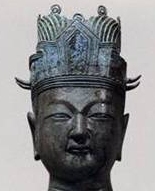
Background
Silla, which had accomplished an incomplete unification of the Three Kingdoms of Korea in 668, weakened and lost control over local lords during the end of the 9th century. The country entered a period of civil war and rebellion, led by Gung Ye, Gi Hwon, Yang Gil, and Gyeon Hwon.
Gung Ye established Hugoguryeo (meaning "Later Goguryeo", renamed Taebong and Majin). Gyeon Hwon established Hubaekje (meaning "Later Baekje"). Together with the declining Silla, they are known as the Later Three Kingdoms.
Founding
Wang Geon, a descendant of a merchant family of Songdo (present-day Kaesŏng), joined Taebong but overthrew Gung Ye and established the Goryeo Kingdom and Dynasty in 918.
Goryeo adopted a Silla-friendly Hubaekje-hostile stage in the later Three Kingdoms, but in 927, Goryeo was defeated by Hubaekje in present-day Daegu. Wang Geon lost his best supporters in the battle. For 3 years after the battle, Hubaekje dominated the Later Three Kingdoms but after a defeat at the Andong in 930, Hubaekje lost his power.
The Later Three Kingdoms era ended as Goryeo annexed Silla in 935 and defeated Hubaekje in 936. Wang Geon moved the capital to his hometown Kaesǒng, and ruled the Korean peninsula as the first King of Goryeo. Wang Geon married a daughter of the Silla royal family and let most nobles keep their lands. Even though Wang Geon ruled the united nation for only 7 years before his son took the reign after his death, the succession was not challenged.
Political structure
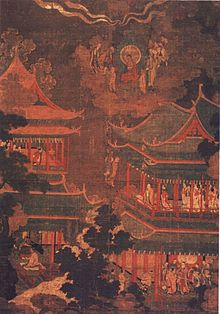
The terminology used in the court of Goryeo was that of an empire, not of a kingdom. The capital, Gaegyeong (Korean: 개경,Hanja: 開京,) was called "Imperial Capital" (Korean: 황도, Hanja: 皇都) and the palace was referred to as "Imperial Palace" (Korean: 황성, Hanja: 皇城). The nation also utilized a system of multiple capitals: Gaegyeong (modern-day Gaeseong), being the main capital, and Seogyeong (Korean: 서경, Hanja: 西京) (modern-day Pyongyang), Namgyeong (Korean: 남경, Hanja: 南京) (modern-day Seoul), and Donggyeong (Korean: 동경, Hanja: 東京) (modern-day Gyeongju) as secondary capitals. The mere use of this system and the nomenclature or use of the character "京“ implied that Goryeo functioned internally as an empire.
Other terms, such as "Your Imperial Majesty" (Korean: 성상, Hanja: 聖上), "Empress" (Korean: 황후, Hanja: 皇后) "Imperial Crown Prince" (Korean: 태자, Hanja: 太子), "Empress Dowager" (Korean: 태후, Hanja: 太后), and "Imperial Ordinance" (詔 or 勅) also suggest that Goryeo adopted the title system of an empire. However, Goryeo, when enshrining its rulers, did not use the title of "Emperor" (Korean: 황제, Hanja: 皇帝). Instead, the title of "Great King" (Korean: 대왕, Hanja: 大王) was used to posthumously enshrine Goryeo monarchs. When enshrining its rulers, however, it did use "temple names" such as Taejo (Korean: 태조, Hanja: 太祖); this is a practice mere kingdoms did not take part in. Imperial titles, like Emperor or "Haedong Emperor" (Korean: 해동천자, Hanja: 海東天子, lit. the Son of Heaven Ruling the Land East of the Sea)" were also used.
After the Mongol invasions, all of these terms were prohibited by Mongol rulers, and Goryeo monarchs were forced to insert the character “忠” (Korean: 충, romanization: "chung"), meaning loyal, into their posthumous enshrinement names. This is why the monarchs after Wonjong had this character "忠” in their posthumous names, up until Gongmin. As Mongol power diminished, rulers no longer used "忠,” but still were unable to restore the use of the temple name.
In order to strengthen the power of the central government, Gwangjong, the fourth emperor, made a series of laws including that of freeing slaves in 958, and one creating the exam for hiring civil officials. To assert power internationally, Gwangjong also proclaimed Goryeo an empire, independent from any other country of its day.
The fifth king, Gyeongjong, launched land-ownership reformation called Jeonsigwa (Korean: 전시과, Hanja: 田柴科) and the 6th king, Seongjong of Goryeo appointed officials to local areas, which were previously succeeded by the lords. Between 993 and 1019, the Goryeo-Khitan Wars ravaged the northern border.
By the time of eleventh king, Munjong of Goryeo, the central government of Goryeo gained complete authority and power over local lords. Munjong and later kings emphasized the importance of civilian leadership over the military.
Khitan invasions and Jurchen expedition
Main article: Goryeo-Khitan WarsIn 993, the Khitan Liao Dynasty invaded Goryeo's northwest border with an estimated 60,000 troops. However, after Seo Hui's negotiation with Khitan, they withdrew and ceded territory to the east of the Amrok River (also called Yalu River) when Goryeo agreed to end its alliance with Song Dynasty China. However, Goryeo continued to communicate with the Song, having strengthened its position by building a fortress in the newly gained northern territories.
Meanwhile, In 1009, General Gang Jo of Goryeo led a coup against King Mokjong, killing the monarch and establishing military rule. In 1010, The Khitan attacked again with 400,000 troops during an internal Goryeo power struggle. Gang Jo blocked the Liao invasions until his own death. The Goryeo King Hyeonjong was forced to flee the capital to Naju temporarily. Unable to establish a foothold and fearing a counterattack, the Khitan forces withdrew.
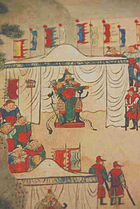
In 1018, the Khitan army invaded for the third time with 100,000 troops. In Heunghaejin stream, General Gang Gam-chan ordered the stream to be blocked until the Khitans began to cross it, and when the Khitans were mid-way across, he ordered that the dam be destroyed so that the water would drown much of the Khitan army. The damage was great, and General Gang led a massive attack that annihilated many of the Khitan army. Barely a few thousand of the Liao troops survived after the bitter defeat at Kwiju one year later.
Meanwhile, the Jurchen tribes lived to the north of Goryeo. The Jurchens always rendered tribute to the Goryeo monarchs, but the Jurchen tribes grew strong, and were soon united under Wanyan. They began to violate the Goryeo-Jurchen borders, and eventually invaded Goryeo. In 1087, the first version of the Tripitaka Koreana was completed, after many years of labor.
In 1107, General Yun Gwan led the newly formed Goryeo army, a force of approximately 17,000 men called Byeolmuban, and attacked the Jurchens. Though the war lasted for several years, the Jurchen were ultimately defeated, and surrendered to Yun Gwan. To mark the victory, General Yun built nine fortresses to the northeast of the Goryeo-Jurchen borders (Korean:동북 9성, Hanja:東北九城). In 1108, however, General Yun was given orders to withdraw his troops by Goryeo's new ruler, King Yejong. Due to manipulation and court-intrigue from opposing factions, he was discharged from his post. Along with this, the opposing factions fought to make sure that the new nine fortresses were returned to the Jurchens.
Power struggles
| Monarchs of Korea |
| Goryeo |
|---|
|
The House Yi of Inju (Korean: 인주 이씨, Hanja: 仁州李氏) married the Kings from Munjong to the 17th King, Injong. Eventually the Yis gained more power than the monarch himself. This led to the coup of Yi Ja-gyeom in 1126. The coup failed but the power of the monarch was weakened; Goryeo underwent a civil war among the nobility.
In 1135, Myo Cheong argued in favor of moving the capital to Seogyeong (present day P'yŏngyang). This proposal divided the nobles of Goryeo in half. One faction, led by Myo Cheong, believed in moving the capital to Pyongyang and expanding into Manchuria. The other one, led by Kim Bu-sik (author of the Samguk Sagi), wanted to keep the status quo. Myo Cheong failed to persuade the King and rebelled against the central government and made a country named Daebang, but failed and was killed.
Military regime
Main article: Goryeo military regime| This section needs expansion. You can help by adding to it. (May 2012) |
In 1170, a group of army officers led by Jeong Jung-bu, Yi Ui-bang and Yi Go launched a coup d'état and succeeded. King Uijong went into exile and King Myeongjong was placed on the throne. Effective power, however, lay with a succession of generals who used an elite guard unit known as the Tobang to control the throne: military rule of Goryeo had begun. In 1179, the young general Gyeong Dae-seung rose to power and began an attempt to restore the full power of the monarch and purge the corruption of the state.
However, he died in 1183 and was succeeded by Yi Ui-min, who came from a nobi (slave) background. His unrestrained corruption and cruelty led to a coup by general Choe Chungheon, who assassinated Yi Ui-min and took supreme power in 1197. For the next 61 years, the Choe house ruled as military dictators, maintaining the Kings as puppet monarchs; Choe Chungheon was succeeded in turn by his son Choe U, his grandson Choe Hang and his great-grandson Choe Ui. On taking power, Choe Chungheon forced Myeongjong off the throne and replaced him with King Sinjong, but after Sinjong died he forced two further monarchs off the throne until he found the pliable King Gojong.
Mongol invasions
Main article: Mongol invasions of Korea

In 1231, Mongols under Ögedei Khan invaded Goryeo, following the aftermath of joint Goryeo-Mongol forces against the Khitans in 1219. The royal court moved to Ganghwa Island in the Bay of Gyeonggi, in 1232. The military ruler of the time, Choe U (최우), insisted on fighting back. Goryeo resisted for about 30 years but finally sued for peace in 1259.
Meanwhile, the Mongols began a campaign from 1231 to 1259 that ravaged parts of Gyeongsang and Jeolla provinces. There were six major campaigns: 1231, 1232, 1235, 1238, 1247, 1253; between 1253 and 1258, the Mongols under Möngke Khan's general Jalairtai Qorchi launched four devastating invasions in the final successful campaign against Korea, at tremendous cost to civilian lives throughout the Korean peninsula.
Civilian resistance was strong, and the Imperial Court at Ganghwa attempted to strengthen its fortress. Korea won several victories but the Korean military could not withstand the waves of invasions. The repeated Mongol invasions caused havoc, loss of human lives and famine in Korea. In 1236, Gojong ordered the re-creation of the Tripitaka Koreana, destroyed during the 1232 invasion. This collection of Buddhist scriptures took 15 years to carve on some 81,000 wooden blocks, and is preserved to this day. In March 1258, the dictator Choe Ui was assassinated by Kim Jun. Thus, dictatorship by his military group was ended, and the scholars who had insisted on peace with Mongolia gained power. Eventually, the scholars sent an envoy to the Mongols, and a peace treaty was contracted between the Mongol Empire and Goryeo. Some military officials who refused to surrender formed the Sambyeolcho Rebellion and resisted in the islands off the southern shore of the Korean peninsula.
The treaty permitted the sovereign power and traditional cultures of Goryeo, and implied that the Mongols had no plans of controlling Goryeo. The Mongols annexed the northern areas of Korean peninsula after the invasions and incorporated them into their empire. After the peace treaty with Goryeo, the Mongols planned to conquer Japan by allying with Goryeo troops again; in 1274 and 1281 two campaigns to Japan took place; however, it failed due to a heavy storm (called the Kamikaze) and strong military resistance.
The Goryeo became "quda" (marriage alliance) state of the Yuan dynasty and monarchs of Goryeo were mainly imperial sons in-law (khuregen). The Kings of Goryeo held an important status like other important families of Mardin, Uighurs and Mongols (Oirat, Hongirat, and Ikeres). It is claimed that one of Goryeo monarchs was the most beloved grandson of Kublai Khan.
The Goryeo Dynasty survived under Yuan influences until King Gongmin began to push Yuan garrisons back around 1350. By the 1350s Goryeo regained its lost northern territories.
Most beneficial aspects of the Mongol domination of Eurasia was cultural exchange and flourishing international trade between east and west. The Mongols certainly learned Korean ideas and technology and those benefits of the growing world empire also influenced the knowledge of cartography and production of pottery in Goryeo. Due to high military preparedness of the Goryeo and Mongol allies in Korea, particularly during the Sambyolch'o rebellion in Cheju and southernmost Korea and Mongol invasions of Japan, and the awareness of Kamakura in Japan led to the decline in Wako (Japanese pirates) raids into Korean peninsula. No more raids of Japanese again heard until 1350 when the Mongols were suffering from massive rebellions in China.
Last reform

When King Gongmin ascended to the throne Goryeo was under the influence of the Mongol Yuan Dynasty. He was forced to spend many years in the Yuan court, being sent there in 1341 as a virtual prisoner before becoming king. He married the Mongol princess Queen Noguk. But in the mid-14th century Yuan was beginning to crumble, soon to be replaced by the Ming dynasty in 1368. King Gongmin began efforts to reform the Goryeo government and remove Mongolian influences.
His first act was to remove all pro-Mongol aristocrats and military officers from their positions. Mongols had annexed the northern provinces of Goryeo after the invasions and incorporated them into their empire as the Ssangseong (쌍성총관부, 雙城摠管府) and Dongnyeong Prefectures (동녕부, 東寧府). The Goryeo army retook these provinces partly thanks to defection from Yi Ja-chun, a minor Korean official in service of Mongols in Ssangseong, and his son Yi Seonggye. In addition, Generals Yi Seonggye and Ji Yongsu led a campaign into Liaoyang.
But after the death of Gongmin's wife Queen Noguk in 1365, he fell into depression. In the end, he became indifferent to politics and entrusted that great task to the buddhist monk Shin Don (신돈, 辛旽). But after six years, Shin Don lost his position. In 1374, Gonmin was killed by Choe Man-saeng (최만생) and others.
Fall
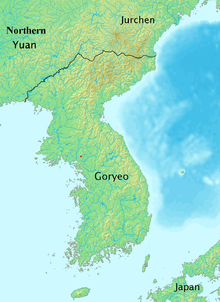
In 1388, King U (son of King Gongmin and a concubine) and general Choe Yeong planned a campaign to invade present-day Liaoning of China. King U put the general Yi Seong-gye (later Taejo) in charge, but he stopped at the border and rebelled.
Goryeo fell to General Yi Seong-gye, a son of a Yi Ja-chun, who put to death the last three Goryeo Kings, usurped the throne and established in 1392 the Joseon Dynasty.
Foreign relations
During the 10th century, the Khitans tried to establish relations with Goryeo at least on two occasions. In 942, the Khitan ruler Taizu sent an embassy with a gift of 50 camels to Goryeo, but Taejo refused them, banishing the envoys and starving the camels to death.
Goryeo had maintained relations with most of the Five Dynasties and southern kingdoms in China. By 962, formal relations were established with the Song dynasty. Relations with Song were close, with many embassies being exchanged between Goryeo and Song, but relations would be interrupted by the rise of the Liao and Jin dynasties.
After about 30 years of peace, the Khitans invaded Goryeo. It failed and after two other failed attempts, a state of peace was established in the Far East. For around 100 years, the Far East was relatively peaceful and Munjong strengthened the Liao-Song-Goryeo line.
In 1102, the Jurchen threatened and another crisis emerged. But after Jin agreed to a tributary relationship with Goryeo, peace was maintained and Jin never actually did invade Goryeo.
Tension continued through the 12th century and into the 13th century, when the Mongol invasions started. After a series of battles, Goryeo capitulated to the Mongols, with the direct dynastic rule of Goryeo monarchy.
Economy
Commerce
In the Goryeo dynasty, trade was frequent. In the start of the dynasty, Byeokrando was the main port. Byeokrando was a port close to the Goryeo capital. Trade included:
| # | Trading country | Import | Export | |
| 1 | Song dynasty | Silk, pearls, tea, spices, medicine, books, instruments | Gold and silver, ginseng, marble, paper, ink | |
| 2 | Liao dynasty | Horses, sheep, low-quality silk | Minerals, cotton, marble, ink and paper, ginseng | |
| 3 | Jurchen | Gold, horses, weapons | Silver, cotton, silk | |
| 4 | Japan | Mercury, minerals | Ginseng, books | |
| 5 | Abbasid dynasty | Mercury, spices, tusk | Gold, silver |
Society

Nobility
Main article: Korean nobilityAt the time of Goryeo, Korean nobility was divided into 6 classes.
- Gukgong (국공, 國公), Duke of a nation
- Gungong (군공, 郡公), Duke of a county
- Hyeonhu (현후, 縣侯), Marquis of a town
- Hyeonbaek (현백, 縣伯), Count of a town
- Gaegukja (개국자, 開國子), Viscount of a town
- Hyeonnam (현남, 縣男), Baron of a town
Also the title Taeja (Korean: 태자, Hanja: 太子) was given to sons of emperor. In most other east Asian countries this title meant crown prince. It was similar to Chinwang (Korean: 친왕, Hanja: 親王) of the Korean Empire.
Religion
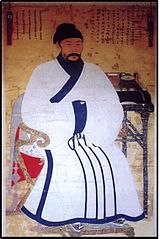
Confucianism
Main article: Korean ConfucianismEmperor Gwangjong creating the national civil service examinations. and King Seongjong was a key figure in establishing Confucianism. King Seongjong established Gukjagam. Gukjagam was the highest educational institution of the Goryeo dynasty. This was facilitated by the establishment in 1398 of the Seonggyungwan – an academy with a Confucian curriculum – and the building of an altar at the palace, where the king would worship his ancestors.
Buddhism
Main article: Korean Buddhism § Buddhism as state religion in the Goryeo period (918-1392)
Buddhism in medieval Korea evolved in ways which rallied support for the state.
Initially, the new Seon schools were regarded by the established doctrinal schools as radical and dangerous upstarts. Thus, the early founders of the various "nine mountain" monasteries met with considerable resistance, repressed by the long influence in court of the Gyo schools. The struggles which ensued continued for most of the Goryeo period, but gradually the Seon argument for the possession of the true transmission of enlightenment would gain the upper hand. The position that was generally adopted in the later Seon schools, due in large part to the efforts of Jinul, did not claim clear superiority of Seon meditational methods, but rather declared the intrinsic unity and similarities of the Seon and Gyo viewpoints. Although all these schools are mentioned in historical records, toward the end of the dynasty, Seon became dominant in its effect on the government and society, and the production of noteworthy scholars and adepts. During the Goryeo period, Seon thoroughly became a "religion of the state," receiving extensive support and privileges through connections with the ruling family and powerful members of the court.
Although most of the scholastic schools waned in activity and influence during this period of the growth of Seon, the Hwaeom school continued to be a lively source of scholarship well into the Goryeo, much of it continuing the legacy of Uisang and Wonhyo. In particular the work of Gyunyeo (均如; 923-973) prepared for the reconciliation of Hwaeom and Seon, with Hwaeom's accommodating attitude toward the latter. Gyunyeo's works are an important source for modern scholarship in identifying the distinctive nature of Korean Hwaeom.
Another important advocate of Seon/Gyo unity was Uicheon. Like most other early Goryeo monks, he began his studies in Buddhism with the Hwaeom school. He later traveled to China, and upon his return, actively promulgated the Cheontae (天台宗, or Tiantai in Chinese) teachings, which became recognized as another Seon school. This period thus came to be described as "five doctrinal and two meditational schools" (ogyo yangjong). Uicheon himself, however, alienated too many Seon adherents, and he died at a relatively young age without seeing a Seon-Gyo unity accomplished.

The most important figure of Seon in the Goryeo was Jinul (知訥; 1158–1210). In his time, the sangha was in a crisis of external appearance and internal issues of doctrine. Buddhism had gradually become infected by secular tendencies and involvements, such as fortune-telling and the offering of prayers and rituals for success in secular endeavors. This kind of corruption resulted in the profusion of increasingly larger numbers of monks and nuns with questionable motivations. Therefore, the correction, revival, and improvement of the quality of Buddhism were prominent issues for Buddhist leaders of the period.
Jinul sought to establish a new movement within Korean Seon, which he called the "samādhi and prajñā society", whose goal was to establish a new community of disciplined, pure-minded practitioners deep in the mountains. He eventually accomplished this mission with the founding of the Seonggwangsa monastery at Mt. Jogye (曹溪山). Jinul's works are characterized by a thorough analysis and reformulation of the methodologies of Seon study and practice. One major issue that had long fermented in Chinese Seon, and which received special focus from Jinul, was the relationship between "gradual" and "sudden" methods in practice and enlightenment. Drawing upon various Chinese treatments of this topic, most importantly those by Zongmi (780-841) and Dahui (大慧; 1089–1163), Jinul created a "sudden enlightenment followed by gradual practice" dictum, which he outlined in a few relatively concise and accessible texts. From Dahui, Jinul also incorporated the gwanhwa (觀話) method into his practice. This form of meditation is the main method taught in Korean Seon today. Jinul's philosophical resolution of the Seon-Gyo conflict brought a deep and lasting effect on Korean Buddhism.
The general trend of Buddhism in the latter half of the Goryeo was a decline due to corruption, and the rise of strong anti-Buddhist political and philosophical sentiment. However, this period of relative decadence would nevertheless produce some of Korea's most renowned Seon masters. Three important monks of this period who figured prominently in charting the future course of Korean Seon were contemporaries and friends: Gyeonghan Baeg'un (景閑白雲; 1298–1374), Taego Bou (太古普愚; 1301–1382) and Naong Hyegeun (懶翁慧勤; 1320–1376). All three went to Yuan China to learn the Linji (臨濟 or Imje in Korean) gwanhwa teaching that had been popularized by Jinul. All three returned, and established the sharp, confrontational methods of the Imje school in their own teaching. Each of the three was also said to have had hundreds of disciples, such that this new infusion into Korean Seon brought about considerable effect. Despite the Imje influence, which was generally considered to be anti-scholarly in nature, Gyeonghan and Naong, under the influence of Jinul and the traditional tong bulgyo tendency, showed an unusual interest in scriptural study, as well as a strong understanding of Confucianism and Taoism, due to the increasing influence of Chinese philosophy as the foundation of official education. From this time, a marked tendency for Korean Buddhist monks to be "three teachings" exponents appeared.
A significant historical event of the Goryeo period is the production of the first woodblock edition of the Tripitaka, called the Tripitaka Koreana. Two editions were made, the first one completed from 1210 to 1231, and the second one from 1214 to 1259. The first edition was destroyed in a fire, during an attack by Mongol invaders in 1232, but the second edition is still in existence at Haeinsa in Gyeongsang province. This edition of the Tripitaka was of high quality, and served as the standard version of the Tripitaka in East Asia for almost 700 years.
Islam
Small-scale contact with predominantly Muslim peoples continued on and off. During the late Goryeo period, there were mosques in the capital Gaeseong.
Among such Muslims was Samgha who was renamed Jang Sunnyong, he married a Korean and became the founding ancestor of the Deoksu Jang clan. His clan produced many high officials and respected Confucian scholars over the centuries. Another Muslim named Seol Son fled to Korea when the Red Turban Rebellion erupted near the end of the Yuan dynasty. He, too, married a Korean, originating a lineage called the Gyeongju Seol clan.
Culture
Tripitaka Koreana
Main article: Tripitaka KoreanaTripitaka Koreana (팔만대장경) is a Tripitaka with approximately 80,000 Buddhist scripts. The scripts are stored in Haeinsa, South Gyeongsang province. Made in 1251 by Gojong in an attempt to fight away the Mongol invasions by Buddhism. The scripts are kept clean by leaving them to dry outside every year.
Art
Goryeo celadon
Main article: Korean pottery and porcelain
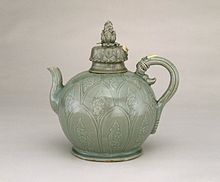
The ceramics of Goryeo are considered by some to be the finest small-scale works of ceramics in Korean history. Key-fret, foliate designs, geometric or scrolling flowerhead bands, elliptical panels, stylized fish and insects, and the use of incised designs began at this time. Glazes were usually various shades of celadon, with browned glazes to almost black glazes being used for stoneware and storage. Celadon glazes could be rendered almost transparent to show black and white inlays.
While the forms generally seen are broad-shouldered bottles, larger low bowls or shallow smaller bowls, highly decorated celadon cosmetic boxes, and small slip-inlaid cups, the Buddhist potteries also produced melon-shaped vases, chrysanthemum cups often of spectacularly architectural design on stands with lotus motifs and lotus flower heads. In-curving rimmed alms bowls have also been discovered similar to Korean metalware. Wine cups often had a tall foot which rested on dish-shaped stands.
Lacquerware with Mother of Pearl Inlay
During the Goryeo period, lacquerware with mother-of-pearl inlay reached a high point of technical and aesthetic achievement and was widely used by members of the aristocracy for Buddhist ritual implements and vessels, as well as horse saddles and royal carriages. Inlaid lacquers combine texture, color, and shape to produce a dazzling effect in both large and small objects. Although Korean lacquerware of the Goryeo period was highly prized throughout East Asia, fewer than fifteen examples are known to have survived, one of which is this exquisite box in the Museum's collection. This paucity of material is largely attributable to the fragility of lacquer objects and, to a certain extent, to wars and raids by foreign powers, notably those launched from Japan by Toyotomi Hideyoshi (1536–1598) in the late sixteenth century.
More info on Goryeo lacquerware
Construction techniques
These ceramics are of a hard porcellaneous body with porcelain stone as one of the key ingredients; however, it is not to be confused with porcelain. The body is low clay, quartz rich, high potassia and virtually identical in composition to the Chinese Yueh ceramics which scholars hypothesize occasioned the first production of celadon in Korea. The glaze is an ash glaze with iron colourant, fired in a reduction atmosphere in a modified Chinese-style 'dragon' kiln. The distinctive blue-grey-green of Korean celadon is caused by the iron content of the glaze with a minimum of titanium contaminant, which modifies the color to a greener cast, as can be seen in Chinese Yueh wares. However, the Goryeo potters took the glaze in a different direction than their Chinese forebears; instead of relying solely on underglaze incised designs, they eventually developed the sanggam technique of inlaying black (magnetite) and white (quartz) which created bold contrast with the glaze. Scholars also theorize that this developed in part to an inlay tradition in Korean metalworks and lacquer, and also to the dissatisfaction with the nearly invisible effect of incising when done under a thick celadon glaze.
Technology
Main article: Science and technology in Korea
In 1234, the world's first metal movable type printing was invented by Choe Yun-ui in Goryeo. Sangjeong Gogeum Yemun were printed with the movable metal type in 1234. Technology in Korea took a big step in Goryeo and strong relation with the Song dynasty contributed to this. In the dynasty, Korean ceramics and paper, which come down to now, started to be manufactured.
During the late Goryeo Dynasty, Goryeo was at the cutting edge of shipboard artillery. In 1356 early experiments were carried out with gunpowder weapons that shot wood or metal projectiles. In 1373 experiments with incendiary arrows and "fire tubes" possibly an early form of the Hwacha were developed and placed on Korean warships. The policy of placing cannons and other gunpowder weapons continued well into the Joseon Dynasty and by 1410, over 160 Joseon warships had cannons on board. Choe Mu-seon, a medieval Korean inventor, military commander and scientist who introduced widespread use of gunpowder to Korea for the first time and creating various gunpowder based weapons.
See also
- List of Korea-related topics
- List of Korean monarchs#Goryeo
- Names of Korea
- Genealogy of the Goryeo Dynasty
- The History of the Koryo Dynasty (高麗史, the 1st source written in Hanja, the file type is PDF.) Seoul National Univ.
Notes
- Kwak, p. 99., p. 99, at Google Books; excerpt, "Korea's tributary relations with China began as early as the fifth century, were regularized during the Goryeo dynasty (918-1392), and became fully institutionalized during the Yi dynasty (1392-1910)."
- Kyu Chull Kim (8 March 2012). Rootless: A Chronicle of My Life Journey. AuthorHouse. p. 128. ISBN 978-1-4685-5891-3. Retrieved 19 September 2013.
- "Koryo Dynasty". Encyclopedia of World History. Vol. II. p. 238.
- Encyclopedia of World History, Vol II, P238 Koryo Dynasty, Edited by Marsha E. Ackermann, Michael J. Schroeder, Janice J. Terry, Jiu-Hwa Lo Upshur, Mark F. Whitters, ISBN 978-0-8160-6386-4
- ^ http://enc.daum.net/dic100/contents.do?query1=b18a0209a |Daum Encyclopædia Britannica
- ^ http://www.wontackhong.com/homepage1/data/1131.pdf
- 국방부 군사편찬연구소, 고려시대 군사 전략 (2006) (The Ministry of National Defense, Military Strategies in Goryeo)
- 국사편찬위원회, 고등학교국사교과서 p63(National Institute of Korean History, History for High School Students, p64)
- Ed. Morris Rossabi - China among equals: the Middle Kingdom and its neighbors, 10th-14th centuries, p.244
- The Mongols Co-opt the Turks to Rule All under Heaven: Crippled the Dual-System and Expelled by Chinese Rebellion by Wontack Hong
- Baasanjavyin Lkhagvaa-Solongos, Mongol-Solongosyin harilstaanii ulamjlalaas, p.172
- ^ Thomas T. Allsen - Culture and Conquest in Mongol Eurasia, p.53
- Namjil- Solongos-Mongolyin haritsaa: Ert, edugee, p.64
- Henthorn, William E. (1963). Korea: the Mongol invasions (PDF). E.J. Brill. pp. 226–234.
- Benjamin H. Hazard-The Formative Years of The Wakō, 1223-63, Monumenta Nipponica, Vol. 22, No. 3/4 (1967), pp. 260-277
- Vermeersch, Sem. (2008). The Power of the Buddhas: the Politics of Buddhism during the Koryŏ Dynasty (918-1392), p. 3.
- "Islam takes root and blooms". Islam Korea. Retrieved 20 March 2006.
- Wood, Nigel. "Technological Parallels between Chinese Yue wares and Korean celadons." in Papers of the British Association for Korean Studies (BAKS Papers), vol 5. Gina Barnes and Beth McKillop, eds. London: British Association for Korean Studies, 1994; pp. 39-64.
- The official history of Koryo, is printed by woodblock 1580.
References
- Vermeersch, Sem. (2008). The Power of the Buddhas: the Politics of Buddhism during the Koryǒ Dynasty (918-1392). Cambridge: Harvard University Press. 13-ISBN 9780674031883/10-ISBN 0674031881; OCLC 213407432
